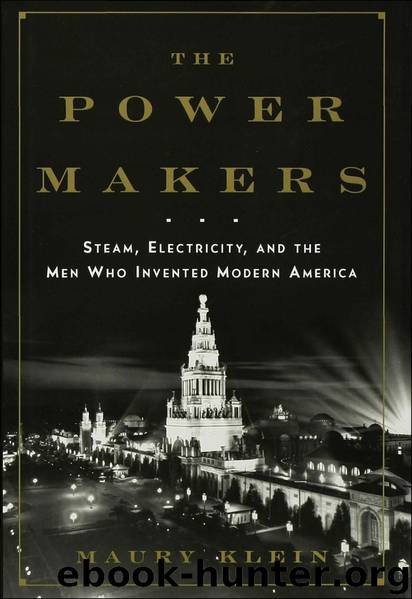The Power Makers by Maury Klein

Author:Maury Klein
Language: eng
Format: epub
Tags: ebook, book
Publisher: Bloomsbury Publishing Plc
Published: 2010-04-23T04:00:00+00:00
CHAPTER 14
MONEY, MERGERS, AND MOTORS
With the advent of the dynamo electricity has taken a new and very much larger place in the commercial activities of the world. It runs and warms our cars, it furnishes our light, it plates our metals, it runs our elevators, it electrocutes our criminals; and a thousand other things it performs for us with secrecy and dispatch in its silent and forceful way.
—EDWARD W. BYRN(1900)1
BY 1890 THE WAR OF THE CURRENTS had cast the electrical industry in an entirely new light. Only a decade earlier it had been an infant struggling to be born, a flicker of development suddenly propelled by Edison’s new lamp. First lighting and then the street railway, or traction, fed its growth, and with it came the fierce competitive wars so typical of fledgling industries grounded in new technological breakthroughs. Within a remarkably short time the list of eager young firms had been winnowed into three dominant ones: Edison General Electric, Thomson-Houston, and Westinghouse. Competition enabled, indeed forced, all three companies to grow, and size intensified the competition among them by raising the stakes of failure. The larger they became, the more costly grew failures, missteps, or the competitive wars that bled their balance sheets.2
To make matters worse, they had created a capital-intensive industry in a sector that was itself novel. Securities in industrial corporations were largely terra incognita to most investors. The most traditional source of investment for people with money had always been land or its upscale urban relative, real estate. Government securities constituted another outlet for surplus funds, along with public improvement projects like canals, docks, or roadways. The advent of the railroad, the nation’s first and most capital-intensive big business, transformed the capital market no less than the business and physical landscape. The railroad mania literally created the modern American capital market and with it the stock exchanges that came to be dominated by rail securities along with a smattering of government issues.
The term “industrial securities” did not even come into existence until 1889. In that year no fewer than ten railroads had a net worth exceeding $100 million, led by the mighty Pennsylvania Railroad at more than $200 million. Only a handful of industrial firms boasted a capital of even $10 million. Except for coal mines and a few New England textile mills, industrial stocks did not exist on public exchanges. Most manufacturing firms were privately owned and resorted to private borrowing to raise capital. Railroads deviated from this pattern only because their capital needs were far too large to obtain from any form of organization other than a corporation featuring limited liability. Even giant firms like Standard Oil or Carnegie’s iron and steel works did not sell stock to the public but kept it in the hands of its own circle. These companies had the ability to raise capital internally and so rarely needed bankers to do it for them. Down to 1890 investment bankers had waxed fat first on government securities, especially the plethora of offerings during the Civil War, and then on railway securities.
Download
This site does not store any files on its server. We only index and link to content provided by other sites. Please contact the content providers to delete copyright contents if any and email us, we'll remove relevant links or contents immediately.
| Automotive | Engineering |
| Transportation |
Whiskies Galore by Ian Buxton(41879)
Introduction to Aircraft Design (Cambridge Aerospace Series) by John P. Fielding(33064)
Small Unmanned Fixed-wing Aircraft Design by Andrew J. Keane Andras Sobester James P. Scanlan & András Sóbester & James P. Scanlan(32743)
Craft Beer for the Homebrewer by Michael Agnew(18140)
Turbulence by E. J. Noyes(7936)
The Complete Stick Figure Physics Tutorials by Allen Sarah(7307)
Kaplan MCAT General Chemistry Review by Kaplan(6867)
The Thirst by Nesbo Jo(6826)
Bad Blood by John Carreyrou(6552)
Modelling of Convective Heat and Mass Transfer in Rotating Flows by Igor V. Shevchuk(6391)
Learning SQL by Alan Beaulieu(6210)
Weapons of Math Destruction by Cathy O'Neil(6143)
Man-made Catastrophes and Risk Information Concealment by Dmitry Chernov & Didier Sornette(5921)
Digital Minimalism by Cal Newport;(5664)
Life 3.0: Being Human in the Age of Artificial Intelligence by Tegmark Max(5474)
iGen by Jean M. Twenge(5366)
Secrets of Antigravity Propulsion: Tesla, UFOs, and Classified Aerospace Technology by Ph.D. Paul A. Laviolette(5309)
Design of Trajectory Optimization Approach for Space Maneuver Vehicle Skip Entry Problems by Runqi Chai & Al Savvaris & Antonios Tsourdos & Senchun Chai(5011)
Pale Blue Dot by Carl Sagan(4912)
